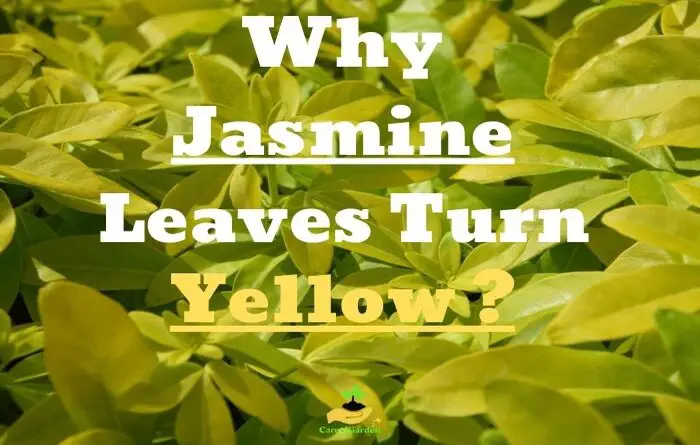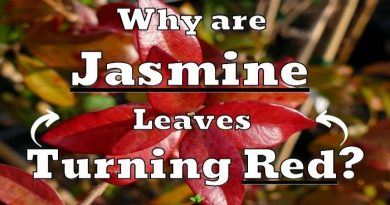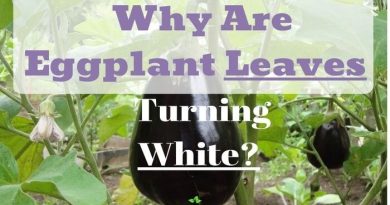Why Are Jasmine Leaves Turning Yellow (5 Causes & How to Prevent)
Many of you ask me why are jasmine leaves turning yellow and in this article, I will give the answer!
Jasmine leaves are turning yellow due to a variety of reasons, including waterlogging, lack of water, nutrient deficiency, pests, improper soil pH, natural aging, and chlorosis. To prevent the yellowing of jasmine leaves, make sure to water the plant properly, provide adequate nutrients, and protect it from pests and diseases.
Causes of Jasmine Leaves Turning Yellow
1. Waterlogging
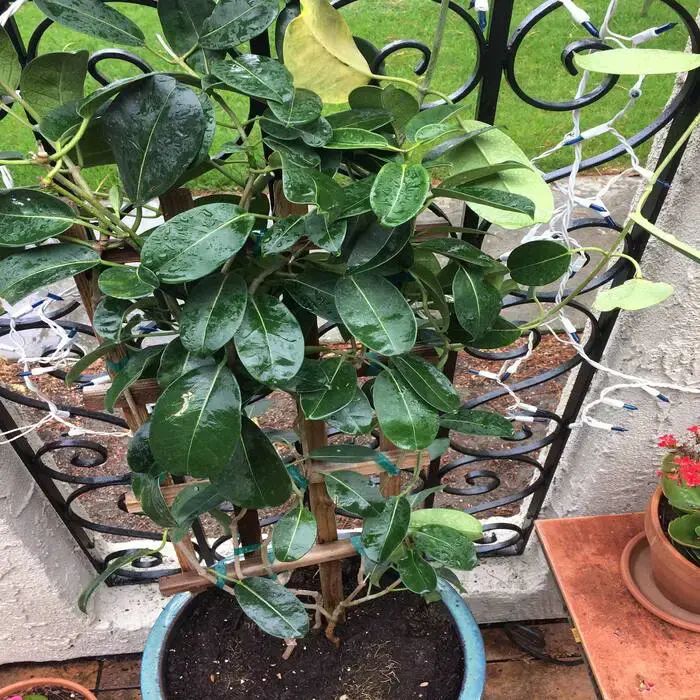
The most common cause why jasmine leaves turn yellow is due to overwatering (waterlogging) and to a cultivation substratum kept humid for a long time, or even soaked with water, in fact, jasmine plants are very afraid of water stagnation, especially when they are grown in pots.
It sounds like you may be watering a bit too frequently if the leaves are turning yellow. I’d try watering only when the top inch or two of soil is dry.
Treatment
You can stick your finger in to check the moisture level. In warmer months, every 3 days is usually plenty. Cut back to once a week in the cooler seasons.
Be sure not to over-saturate the soil either. Water thoroughly until it drains out the bottom, then don’t water again until it’s starting to dry out. Poor drainage is another big problem – the water just sits there and the roots can’t breathe.
Use a well-draining potting mix if you have it in a container. Something light with sand or perlite is ideal. Make sure there are holes in the bottom of the pot too. You can even put gravel or pebbles in the bottom to improve drainage.
2. Lack of water
I’ve found that watering is one of the most important factors in keeping jasmine plants healthy. Yellow leaves often indicate that the soil is too dry. It’s best to water jasmine deeply but infrequently, allowing the soil to dry slightly in between waterings.
This encourages the roots to grow deep in search of moisture. If the top inch or two of soil is dry, it’s time to water. Be careful not to overwater though, as soggy soil can also cause leaves to yellow and drop.
Treatment
| Jasmine Watering Frequency | Soil Moisture Level |
|---|---|
| Every 3-4 days | Keep soil evenly moist |
| Once a week | Adjust based on the plant’s response |
| Every 10-14 days | Allow the top half of the soil to dry out |
| Every 2-3 weeks | Allow soil to dry between watering |
| Varied | Adjust based on the jasmine’s response |
Source: https://hgic.clemson.edu/factsheet/jasmine/
For jasmine showing signs of drought stress like yellow foliage, submerge the pot in a few inches of water for 10-15 minutes to rehydrate the soil from the bottom up before resuming regular watering.
Removing any fully yellow or drooping leaves allows the jasmine to put its energy into new, healthy growth. Proper watering takes some trial and error but is well worth it to keep your jasmine looking its best.
3. Nutrient deficiency

When the jasmine don’t get their necessary nutrients from the soil, the leaves are the first to show the problem since older leaves are less vital. The plant tries to conserve nutrients by pulling them out of leaves it can afford to lose, making them yellow.
| Nutrient Deficiency | Jasmine Symptoms | Common Causes |
|---|---|---|
| Nitrogen (N) | Pale yellow leaves, stunted growth | Inadequate fertilization, poor soil quality |
| Iron (Fe) | Yellowing between leaf veins, leaf chlorosis | High soil pH, insufficient iron uptake |
| Magnesium (Mg) | Yellowing between leaf veins, leaf curling | Low soil magnesium levels, acidic soil |
| Zinc (Zn) | Yellowing of leaf margins, reduced leaf size | Zinc-deficient soil, poor nutrient uptake |
| Manganese (Mn) | Interveinal chlorosis, leaf browning | High pH soils, poor manganese availability |
Source: https://hort.ifas.ufl.edu/database/nutdef/pic17.shtml
Treatment
I also like to make my own organic fertilizer. It’s simple and you probably have a lot of the materials around the house already. Just collect things like egg shells, coffee grounds, fruit and veggie scraps, and even dry leaves or straw.
Toss it all in a compost bin or box. Then cover with some dry material like more leaves or sawdust to absorb moisture as it breaks down. Let it sit for about a month to fully decompose. That homemade compost tea is full of nutrients to feed your jasmine.
Give your jasmine a good feeding of either fertilizer and see if that perks the leaves back up.
Nitrogen Deficiency
Another possibility is a nutrient deficiency, particularly of nitrogen. Nitrogen is key for plant growth and chlorophyll production.
Your jasmine can experience nitrogen deficiencies if the soil isn’t providing enough of it. Heavy watering can actually leach nitrogen out of the soil over time. Too much water is essentially washing away what the plant needs.
Signs of a nitrogen deficiency include yellowing of the older leaves first. The jasmine plant is pulling nitrogen from them to prioritize new growth. Growth may also slow down noticeably if nitrogen is lacking.
Some other nutrients like phosphorus, potassium, magnesium, and nickel are also important. Deficiencies in those can cause similar symptoms – starting with older foliage yellowing as the plant recycles nutrients within itself.
Treatment
If the yellowing isn’t improving with adjusted watering, it may be worth giving the soil a boost with a balanced fertilizer. Something labeled for flowers and foliage should provide the nitrogen and other nutrients jasmine needs.
A little TLC with fertilizer might be just the ticket to get those leaves green and healthy again!
4. Pests
In rare cases, yellow leaves indicate a pest infestation of the jasmine. Check your jasmine regularly for a healthy appearance, so you can recognize a possible pest infestation at an early stage.
| Pest | Sign in Jasmine Leaves | Treatment |
|---|---|---|
| Scale insects | Small, oval, brown or black bumps on leaves or stems | Remove and destroy infested parts, use insecticidal soap or oil |
| Mealybugs | Small, oval, brown, or black bumps on leaves or stems | Wipe off with cotton swabs soaked in alcohol, use insecticidal soap or oil |
| Spider mites | Fine webs on leaves, stippling, and discoloration | Use horticultural oil or insecticidal soap, increase humidity |
Spider Mites
A spider mites infestation, which is a very small insect that is found on the underside of the jasmine leaves. Treat the jasmine plant with potash soap at least 3-4 times with an interval of 5-7 days.
Scale Insects
Scale insects can appear on the jasmines during the spring season or in any case when the climate is mild. They are nothing more than very small insects, whose size does not exceed 3 mm, which suck the lifeblood of the plant by positioning itself on the leaves.
The initial damage caused by these insects is the nuisance of the shoots and leaves which, after being drained of their sap, turn to yellow and fall to the ground.
Mealybugs
Mealybugs are small biting and sap-sucking insects that weaken the plant and cause the jasmine to have yellow foliage. In the long term, sooty mold, a black fungus, invades the plant, making it sticky and risking killing it.
Mealybugs should first be simply scraped off or showered off. If that doesn’t help, it’s best to tackle the pests with beneficial insects such as lacewings or ladybirds.
5. Soil pH Imbalances
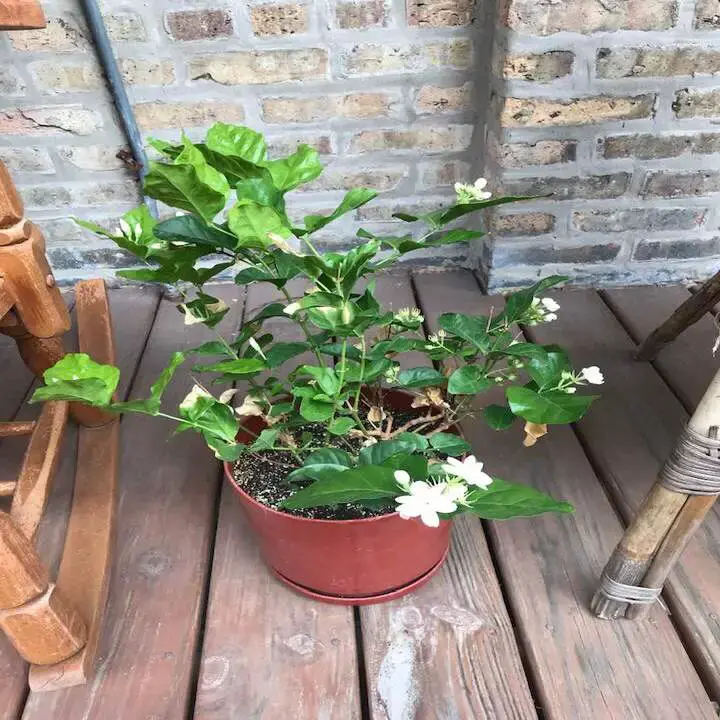
When the soil pH becomes imbalanced, such as in highly alkaline conditions, it can lead to yellowing of the leaves. This happens because certain nutrients become less available to your jasmine plant at extreme pH levels, affecting their ability to carry out essential physiological processes.
| pH Level | Effect on Jasmine Leaves |
|---|---|
| Below 6.0 (acidic) | Can result in nutrient deficiencies, leading to yellowing leaves. |
| 6.0 to 7.0 (slightly acidic to neutral) | Ideal pH range for healthy jasmine plants. |
| Above 7.0 (alkaline) | Can impair nutrient uptake, causing yellowing leaves. |
Treatment
To prevent jasmine leaves from turning yellow due to pH imbalances, it’s important to regularly test the soil pH and adjust it if necessary. The ideal pH range for jasmine plants is slightly acidic to neutral, around 6.0 to 7.0.
If the soil is too alkaline, you can lower the pH by incorporating organic matter like compost or peat moss. On the other hand, if the soil is too acidic, you can raise the pH by adding limestone or wood ash.
6. Natural Aging
If your jasmine does not show any of the changes mentioned above, the yellowing of the leaves is probably a result of natural aging. Because they are living beings, many species have a certain life span and end up deteriorating over time.
If your jasmine gets yellow foliage in the fall before the winter break, which then falls off, this is not a cause for concern, it is quite normal. Because the jasmine always sheds its leaves before wintering.
7. Chloriosis
Another possibility is chlorosis. That’s when the leaves don’t have enough chlorophyll to appear bright green. Chlorophyll allows the plant to transform sunlight into energy through photosynthesis. Without enough, it can struggle.
When the jasmine leaves don’t have enough chlorophyll to stay a nice, bright green, that’s a sign of chlorosis. And chlorophyll plays such an important role – it’s what allows the plant to transform sunlight into energy through photosynthesis.
In this case, I suspect an iron deficiency may be to blame. Iron is key for making chlorophyll, and if the soil isn’t providing enough, the leaves will look pale or yellowish instead of their usual green.
Of course, it’s also normal for older leaves to yellow and drop off naturally. But with this jasmine, the yellowing seems pretty widespread. That, plus how it was struggling, makes me think the chlorosis was preventing photosynthesis.
Treatment
A good application of fertilizer should help correct the iron deficiency. With any luck, that will boost chlorophyll production and get this plant’s leaves bright green again!
How do you fix yellow jasmine leaves
Here are some tips for fixing yellow jasmine leaves:
- Improve drainage and aerate the soil if it’s waterlogged. Add compost or raise the planting area.
- Water properly based on soil moisture levels and plant needs. Too much or too little water can cause issues.
- Test the soil and amend any deficiencies. Common fixes include adding compost, lime to adjust pH, or supplements like iron.
- Check for and treat any pest infestations promptly. Isolate affected areas to prevent spread.
- Prune away severely yellowed or diseased foliage to redirect energy to new growth.
- Fertilize during the growing season with a balanced product. Follow label instructions for proper application.
- Consider supplemental lighting or partial shade if yellowing occurs from too much sun exposure.
- Apply chelated iron treatments to the foliage if leaves appear pale green or yellowish due to an iron deficiency.
- Be patient, as fixes may take a few weeks to show results as new leaves emerge. Monitor and maintain optimal care.
How to Prevent Jasmine Leaves from Turning Yellow
To prevent jasmine leaves from turning yellow, you must follow these simple rules:
Maintain a consistent watering schedule
- Check the soil regularly to keep it moist but not soggy
- For potted jasmines, water when the soil is dry without excess
Assess the soil regularly:
- Amend soil with compost to improve structure and drainage
- Get the soil tested annually to check for nutrient deficiencies
Check Nutrient Levels:
- Supplement specific nutrients based on soil test results
- Fertilize monthly during the growing season with a balanced product
- Use iron supplements like chelated iron for pale leaves
Fertilizer Application:
- Avoid over-fertilization by using less than prescribed amounts
- Apply fertilizers containing micronutrients
- Use foliar spray fertilizer if leaves still yellow with soil treatment
- Increase foliar spraying frequency during hot weather
Pruning and Care:
- Prune off old or diseased foliage for new growth
- Slow watering in fall for dormancy
- Provide adequate winter protection from temperature changes
Conclusion
As much as it is scary and sad to realize that jasmine leaves turning yellow, it is possible to treat them so that they return to their normal health.
Frequently Asked Questions
It’s generally best to prune off severely yellowed or diseased foliage to encourage new growth from healthier parts of the plant.
Once jasmine leaves have turned completely yellow, they will not regain their green pigment. The goal is to prevent further yellowing by treating the cause and growing new foliage.
Overwatering is a common cause of yellowing, especially for potted plants like jasmine. Symptoms to know that jasmine is overwatered: Leaves, and stems soften and sag; The leaves turn yellow and fall; The soil is spongy when you press on it with your finger water can come out; Bumps appear to turn brown and corky.
It can take 1-4 weeks to see results as new leaves emerge after addressing the underlying issue. Be patient during this recovery period.

